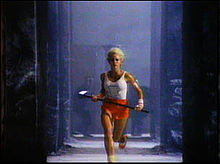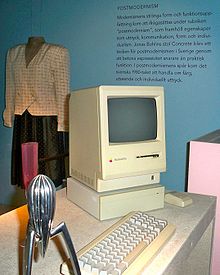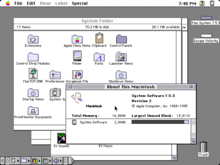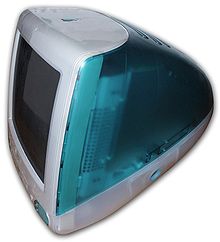- Macintosh
-
This article is about Apple personal computers. For other uses, see McIntosh.
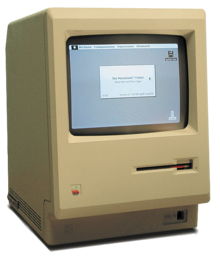 The original Macintosh, the first commercially successful personal computer to use a graphical user interface, rather than a command line.
The original Macintosh, the first commercially successful personal computer to use a graphical user interface, rather than a command line.
 An iMac computer from August 2007, a modern all-in-one Macintosh.
An iMac computer from August 2007, a modern all-in-one Macintosh.
The Macintosh (pronounced /ˈmækɨntɒʃ/ mak-in-tosh),[1] or Mac, is a series of several lines of personal computers designed, developed, and marketed by Apple Inc. The first Macintosh was introduced by Apple's then-chairman Steve Jobs on January 24, 1984; it was the first commercially successful personal computer to feature a mouse and a graphical user interface rather than a command-line interface.[2] The company continued to have success through the second half of the 1980s, first primarily because of the sales of the Apple II series remained strong even after the introduction of the Macintosh, only to see it dissipate in the 1990s as the personal computer market shifted toward the "Wintel" platform: IBM PC compatible machines running MS-DOS and Microsoft Windows.[3]
Years later, Apple consolidated its multiple consumer-level desktop models into the 1998 iMac all-in-one. This proved to be a sales success and saw the Macintosh brand revitalized. Current Mac systems are mainly targeted at the home, education, and creative professional markets. These include the descendants of the original iMac and the entry-level Mac mini desktop models, the Mac Pro tower graphics workstation, the MacBook, MacBook Air and MacBook Pro laptops. The Xserve server was discontinued January 31, 2011.[4]
Production of the Mac is based on a vertical integration model in that Apple facilitates all aspects of its hardware and creates its own operating system that is pre-installed on all Mac computers. This is in contrast to most IBM PC compatibles, where multiple sellers create and integrate hardware intended to run another company's operating software. Apple exclusively produces Mac hardware, choosing internal systems, designs, and prices. Apple does use third party components, however, such as graphics subsystems from nVidia and ATi. Current Mac CPUs use Intel's X86-64 architecture; the earliest models (1984–1994) used Motorola's 68k and models from 1994–2006 used the AIM alliance's PowerPC. Apple also develops the operating system for the Mac, currently Mac OS X version 10.7 "Lion". The modern Mac, like other personal computers, is capable of running alternative operating systems such as Linux, FreeBSD, and, in the case of Intel-based Macs, Microsoft Windows. However, Apple does not license Mac OS X for use on non-Apple computers.
Contents
History
See also: History of Apple1979 to 1984: Development
The Macintosh project started in the late 1970s with Jef Raskin, an Apple employee, who envisioned an easy-to-use, low-cost computer for the average consumer. He wanted to name the computer after his favorite type of apple, the McIntosh,[5] but the name had to be changed for legal reasons as it was too close, phonetically, to that of the McIntosh audio equipment manufacturer. Steve Jobs requested a release of the name so that Apple could use it, but was denied, forcing Apple to eventually buy the rights to use the name.[6] Raskin was authorized to start hiring for the project in September 1979,[7] and he began to look for an engineer who could put together a prototype. Bill Atkinson, a member of Apple's Lisa team (which was developing a similar but higher-end computer), introduced him to Burrell Smith, a service technician who had been hired earlier that year. Over the years, Raskin assembled a large development team that designed and built the original Macintosh hardware and software; besides Raskin, Atkinson and Smith, the team included George Crow,[8] Chris Espinosa, Joanna Hoffman, Bruce Horn, Susan Kare, Andy Hertzfeld, Guy Kawasaki, Daniel Kottke,[9] and Jerry Manock.[10][11]
Smith's first Macintosh board was built to Raskin's design specifications: it had 64 kilobytes (kB) of RAM, used the Motorola 6809E microprocessor, and was capable of supporting a 256×256 pixel black-and-white bitmap display. Bud Tribble, a Macintosh programmer, was interested in running the Lisa's graphical programs on the Macintosh, and asked Smith whether he could incorporate the Lisa's Motorola 68000 microprocessor into the Mac while still keeping the production cost down. By December 1980, Smith had succeeded in designing a board that not only used the 68000, but increased its speed from 5 MHz to 8 MHz; this board also had the capacity to support a 384×256 pixel display. Smith's design used fewer RAM chips than the Lisa, which made production of the board significantly more cost-efficient. The final Mac design was self-contained and had the complete QuickDraw picture language and interpreter in 64 kB of ROM – far more than most other computers; it had 128 kB of RAM, in the form of sixteen 64 kilobit (kb) RAM chips soldered to the logicboard. Though there were no memory slots, its RAM was expandable to 512 kB by means of soldering sixteen IC sockets to accept 256 kb RAM chips in place of the factory-installed chips. The final product's screen was a 9-inch, 512x342 pixel monochrome display, exceeding the prototypes.[12]
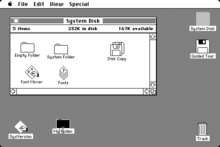 The original 1984 Mac OS desktop featured a radically new graphical user interface. Users communicated with the computer not through abstract textual commands but rather using a metaphorical desktop that included icons of real life items with which the user was already familiar.
The original 1984 Mac OS desktop featured a radically new graphical user interface. Users communicated with the computer not through abstract textual commands but rather using a metaphorical desktop that included icons of real life items with which the user was already familiar.
The design caught the attention of Steve Jobs, co-founder of Apple. Realizing that the Macintosh was more marketable than the Lisa, he began to focus his attention on the project. Raskin finally left the Macintosh project in 1981 over a personality conflict with Jobs, and team member Andy Hertzfeld said that the final Macintosh design is closer to Jobs' ideas than Raskin's.[7] After hearing of the pioneering GUI technology being developed at Xerox PARC, Jobs had negotiated a visit to see the Xerox Alto computer and Smalltalk development tools in exchange for Apple stock options. The Lisa and Macintosh user interfaces were influenced by technology seen at Xerox PARC and were combined with the Macintosh group's own ideas.[13] Jobs also commissioned industrial designer Hartmut Esslinger to work on the Macintosh line, resulting in the "Snow White" design language; although it came too late for the earliest Macs, it was implemented in most other mid- to late-1980s Apple computers.[14] However, Jobs' leadership at the Macintosh project did not last; after an internal power struggle with new CEO John Sculley, Jobs resigned from Apple in 1985,[15] went on to found NeXT, another computer company,[16] and did not return until 1997 when Apple acquired NeXT.[17]
1984: Introduction
The Macintosh 128K was announced to the press in October 1983, followed by an 18-page brochure included with various magazines in December.[18] The Macintosh was introduced by the now famous US$1.5 million Ridley Scott television commercial, "1984".[19] The commercial most notably aired during the third quarter of Super Bowl XVIII on January 22, 1984 and is now considered a "watershed event"[20] and a "masterpiece."[21] "1984" used an unnamed heroine to represent the coming of the Macintosh (indicated by a Picasso-style picture of Apple's Macintosh computer on her white tank top) as a means of saving humanity from the "conformity" of IBM's attempts to dominate the computer industry. The ad alludes to George Orwell's novel, Nineteen Eighty-Four, which described a dystopian future ruled by a televised "Big Brother."[22][23]
Two days after the 1984 ad aired, the Macintosh went on sale. It came bundled with two applications designed to show off its interface: MacWrite and MacPaint. It was first demonstrated by Steve Jobs in the first of his famous Mac Keynote speeches, and though the Mac garnered an immediate, enthusiastic following, some labeled it a mere "toy."[24] Because the operating system was designed largely around the GUI, existing text-mode and command-driven applications had to be redesigned and the programming code rewritten. This was a time-consuming task that many software developers chose not to undertake, and could be regarded as a reason for an initial lack of software for the new system. In April 1984 Microsoft's MultiPlan migrated over from MS-DOS, with Microsoft Word following in January 1985.[25] In 1985, Lotus Software introduced Lotus Jazz for the Macintosh platform after the success of Lotus 1-2-3 for the IBM PC, although it was largely a flop.[26] Apple introduced Macintosh Office the same year with the lemmings ad. Infamous for insulting its own potential customers, the ad was not successful.[27]
For a special post-election edition of Newsweek in November 1984, Apple spent more than US$2.5 million to buy all 39 of the advertising pages in the issue.[28] Apple also ran a "Test Drive a Macintosh" promotion, in which potential buyers with a credit card could take home a Macintosh for 24 hours and return it to a dealer afterwards. While 200,000 people participated, dealers disliked the promotion, the supply of computers was insufficient for demand, and many were returned in such a bad shape that they could no longer be sold. This marketing campaign caused CEO John Sculley to raise the price from US$1,995 to US$2,495 (adjusting for inflation, about $5,200 in 2010).[27][29]
1985 to 1989: Desktop publishing era
In 1985, the combination of the Mac, Apple's LaserWriter printer, and Mac-specific software like Boston Software's MacPublisher and Aldus PageMaker enabled users to design, preview, and print page layouts complete with text and graphics—an activity to become known as desktop publishing. Initially, desktop publishing was unique to the Macintosh, but eventually became available for other platforms as well.[30] Later, applications such as Macromedia FreeHand, QuarkXPress, Adobe Photoshop, and Adobe Illustrator strengthened the Mac's position as a graphics computer and helped to expand the emerging desktop publishing market.
The limitations of the first Mac soon became clear: it had very little memory, even compared with other personal computers in 1984, and could not be expanded easily; and it lacked a hard disk drive or the means to attach one easily. Many small companies sprang up to address the memory issue, by upgrading the 128k Mac to 512 kB, by removing the computer's 16 memory chips and replacing them with larger-capacity chips, a tedious operation that was not always successful. In October 1985, Apple increased the Mac's memory to 512 kB,[31] and offered an upgrade for 128k Macs that involved replacing the logic board. In an attempt to improve connectivity, Apple released the Macintosh Plus on January 10, 1986 for US$2,600. It offered one megabyte of RAM, easily expandable to four by the use of socketed RAM boards, and a SCSI parallel interface, allowing up to seven peripherals—such as hard drives and scanners—to be attached to the machine. Its floppy drive was increased to an 800 kB capacity. The Mac Plus was an immediate success and remained in production, unchanged, until October 15, 1990; on sale for just over four years and ten months, it was the longest-lived Macintosh in Apple's history.[32]
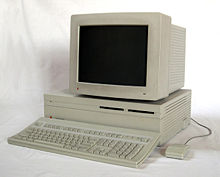 The Macintosh II, one of the first expandable Macintosh models.
The Macintosh II, one of the first expandable Macintosh models.
Updated Motorola CPUs made a faster machine possible, and in 1987 Apple took advantage of the new Motorola technology and introduced the Macintosh II, which used a 16 MHz Motorola 68020 processor.[33] The primary improvement in the Macintosh II was Color QuickDraw in ROM, a color version of the graphics language which was the heart of the machine. Among the many innovations in Color QuickDraw were an ability to handle any display size, any color depth, and multiple monitors.
The Macintosh II marked the start of a new direction for the Macintosh, as now for the first time it had an open architecture with several NuBus expansion slots, support for color graphics and external monitors, and a modular design similar to that of the IBM PC. It had an internal hard drive and a power supply with a fan, which was initially fairly loud.[34] One third-party developer sold a device to regulate fan speed based on a heat sensor, but it voided the warranty.[35] Later Macintosh computers had quieter power supplies and hard drives.
In September 1986, Apple introduced the Macintosh Programmer's Workshop, or MPW that allowed software developers to create software for Macintosh on Macintosh, rather than cross compiling from a Lisa. In August 1987, Apple unveiled HyperCard, and introduced MultiFinder, which added cooperative multitasking to the Macintosh. Apple began bundling both with every Macintosh.
The Macintosh SE was released at the same time as the Macintosh II, as the first compact Mac with a 20 MB internal hard drive and one expansion slot.[36] The SE's expansion slot was located inside the case along with the CRT, potentially exposing an upgrader to high voltage. For this reason Apple recommended users bring their SE to an authorized Apple dealer to have upgrades performed.[37] The SE also updated Jerry Manock and Terry Oyama's original design and shared the Macintosh II's Snow White design language, as well as the new Apple Desktop Bus (ADB) mouse and keyboard that had first appeared on the Apple IIGS some months earlier.
In 1987, Apple spun off its software business as Claris. It was given the code and rights to several applications that had been written within Apple, notably MacWrite, MacPaint, and MacProject. In the late 1980s, Claris released a number of revamped software titles; the result was the "Pro" series, including MacPaint Pro, MacDraw Pro, MacWrite Pro, and FileMaker Pro. To provide a complete office suite, Claris purchased the rights to the Informix Wingz spreadsheet on the Mac, renaming it Claris Resolve, and added the new presentation software Claris Impact. By the early 1990s, Claris applications were shipping with the majority of consumer-level Macintoshes and were extremely popular. In 1991, Claris released ClarisWorks, which soon became their second best-selling application. When Claris was reincorporated back into Apple in 1998, ClarisWorks was renamed AppleWorks beginning with version 5.0.[38]
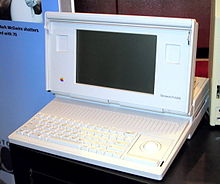 The Macintosh Portable was Apple's first battery-powered Macintosh. It was available from 1989 to 1991 and could run System 6 and System 7.
The Macintosh Portable was Apple's first battery-powered Macintosh. It was available from 1989 to 1991 and could run System 6 and System 7.
In 1988, Apple sued Microsoft and Hewlett-Packard on the grounds that they infringed Apple's copyrighted GUI, citing (among other things) the use of rectangular, overlapping, and resizable windows. After four years, the case was decided against Apple, as were later appeals. Apple's actions were criticized by some in the software community, including the Free Software Foundation (FSF), who felt Apple was trying to monopolize on GUIs in general, and boycotted GNU software for the Macintosh platform for seven years.[39][40]
With the new Motorola 68030 processor came the Macintosh IIx in 1988, which had benefited from internal improvements, including an on-board MMU.[41] It was followed in 1989 by a more compact version with fewer slots (the Macintosh IIcx)[42] and a version of the Mac SE powered by the 16 MHz 68030, the Macintosh SE/30.[43] Later that year, the Macintosh IIci, running at 25 MHz, was the first Mac to be "32-bit clean," allowing it to natively support more than 8 MB of RAM,[44] unlike its predecessors, which had "32-bit dirty" ROMs (8 of the 32 bits available for addressing were used for OS-level flags). System 7 was the first Macintosh operating system to support 32-bit addressing.[45] Apple also introduced the Macintosh Portable, a 16 MHz 68000 machine with an active matrix flat panel display that was backlit on some models.[46] The following year the Macintosh IIfx, starting at US$9,900, was unveiled. Apart from its fast 40 MHz 68030 processor, it had significant internal architectural improvements, including faster memory and two Apple II CPUs dedicated to I/O processing.[47]
1990 to 1998: Growth and decline
 The Macintosh Classic, Apple's early 1990s budget model.
The Macintosh Classic, Apple's early 1990s budget model.
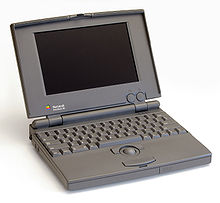 The PowerBook 100 (shown here), 140 and 170 introduced a line of professional laptop Macs. They pioneered notebook ergonomics by placing the keyboard behind a palm rest.
The PowerBook 100 (shown here), 140 and 170 introduced a line of professional laptop Macs. They pioneered notebook ergonomics by placing the keyboard behind a palm rest.
Microsoft Windows 3.0, which began to approach the Macintosh operating system in both performance and feature set,[citation needed] was released in May 1990 and was a less expensive alternative to the Macintosh platform. Apple's response was to introduce a range of relatively inexpensive Macs in October 1990. The Macintosh Classic, essentially a less expensive version of the Macintosh Plus, was the least expensive Mac until early 2001.[48] The 68020-powered Macintosh LC, in its distinctive "pizza box" case, offered color graphics and was accompanied by a new, low-cost 512 × 384 pixel monitor.[49] The Macintosh IIsi was essentially a 20 MHz IIci with only one expansion slot.[50] All three machines sold well,[51] although Apple's profit margin was considerably lower than on earlier machines.[48]
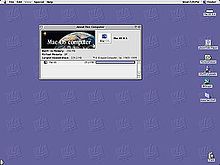 OS 8 was the second major upgrade of the Mac OS. OS 8.6 shown.
OS 8 was the second major upgrade of the Mac OS. OS 8.6 shown.
Apple improved Macintosh computers by introducing models equipped with newly available processors from the 68k lineup. The Macintosh Classic II[52] and Macintosh LC II, which used a 16 MHz 68030 CPU,[53] were joined in 1991 by the Macintosh Quadra 700[54] and 900,[55] the first Macs to employ the faster Motorola 68040 processor. In 1994, Apple abandoned Motorola CPUs for the RISC PowerPC architecture developed by the AIM alliance of Apple Computer, IBM, and Motorola.[56] The Power Macintosh line, the first to use the new chips, proved to be highly successful, with over a million PowerPC units sold in nine months.[57]
Apple replaced the Macintosh Portable in 1991 with the first of the PowerBook line: the PowerBook 100, a miniaturized Portable; the 16 MHz 68030 PowerBook 140; and the 25 MHz 68030 PowerBook 170.[58] They were the first portable computers with the keyboard behind a palm rest, and with a built-in pointing device (a trackball) in front of the keyboard.[59] The 1993 PowerBook 165c was Apple's first portable computer to feature a color screen, displaying 256 colors with 640 x 400 pixel resolution.[60] The second-generation of PowerBooks, the 68040-equipped 500 series, introduced the trackpad, integrated stereo speakers and built-in Ethernet to the laptop form factor in 1994.[61]
As for Mac OS, System 7 was a 32-bit rewrite from Pascal to C++ that introduced virtual memory, and improved the handling of color graphics, memory addressing, networking, and co-operative multitasking. Also during this time, the Macintosh began to shed the "Snow White" design language, along with the expensive consulting fees they were paying to Frogdesign, in favor of bringing the work in-house by establishing the Apple Industrial Design Group. They became responsible for to crafting a new look to go with the new operating system and all other Apple products.[62]
Despite these technical and commercial successes, Microsoft and Intel began to rapidly lower Apple's market share with the Windows 95 operating system and Pentium processors respectively. These significantly enhanced the multimedia capability and performance of IBM PC compatible computers, and brought Windows still closer to the Mac GUI. Furthermore, Apple had created too many similar models that confused potential buyers. At one point Apple's product lineup was subdivided into Classic, LC, II, Quadra, Performa, and Centris models, with essentially the same computer being sold under a number of different names.[63] These models competed against the Macintosh clones, hardware manufactured by third-parties that ran Apple's System 7. This succeeded in increasing the Macintosh's market share somewhat and provided cheaper hardware for consumers, but hurt Apple financially as existing Apple customers began to buy cheaper clones while Apple shouldered the burden of developing the platform.
When Steve Jobs returned to Apple in 1997, he ordered that the OS that had been previewed as version 7.7 be branded Mac OS 8 (in place of the never-to-appear Copland OS). Since Apple had licensed only System 7 to third-parties, this move effectively ended the clone line. The decision caused significant financial losses for companies like Motorola, who produced the StarMax, Umax, who produced the SuperMac,[64] and Power Computing Corporation, who offered several lines Mac clones, including PowerWave, PowerTower, and PowerTower Pro.[65] These companies had invested substantial resources in creating their own Mac-compatible hardware.[66] Apple bought out Power Computing's license, but allowed Umax to continue selling Mac clones until their license expired, as they had a sizeable presence in the lower-end segment that Apple did not.[citation needed]
1998 to 2005: New beginnings
In 1998, a year after Steve Jobs had returned to the company, Apple introduced an all-in-one Macintosh called the iMac. Its translucent plastic case, originally Bondi blue and later many other colors, is considered an industrial design landmark of the late 1990s. The iMac did away with most of Apple's standard (and usually proprietary) connections, such as SCSI and ADB, in favor of two USB ports. It also had no internal floppy disk drive and instead included a CD-ROM drive for installing software,[3][68] but was incapable of writing to CDs or other media without external third-party hardware. The iMac proved to be phenomenally successful, with 800,000 units sold in 139 days,[69] making the company an annual profit of US$309 million—Apple's first profitable year since Michael Spindler took over as CEO in 1995.[70] The iMacs's "blue and white" aesthetic was applied to the Power Macintosh, and then to a new product, the iBook. Introduced in July 1999, the iBook was Apple's first consumer-level laptop computer, filling the missing quadrant of Apple's "four-square product matrix" (desktop and portable products for both consumers and professionals).[71] More than 140,000 pre-orders were placed before it started shipping in September,[72] and by October it was as much a sales hit as the iMac.[73]
In early 2001, Apple began shipping computers with CDRW drives for the first time.[74] Apple had been emphasizing the Mac's ability to play DVDs by including DVD-ROM and DVD-RAM drives as standard. Steve Jobs admitted that Apple had been "late to the party" on writable CD technology but felt that Macs could become a "digital hub" that linked and enabled an "emerging digital lifestyle".[75] Apple would later introduce an update to its iTunes music player software that could burn CDs, along with a controversial "Rip, Mix, Burn" advertising campaign that some[76] felt encouraged media piracy.[77] This accompanied the release of the iPod, Apple's first successful handheld device.
Apple continued to add new products to their lineup, such as the Power Mac G4 Cube,[78] the eMac for the education market and PowerBook G4 laptop for professionals. The original iMac used a G3 processor, but the G4 and then G5 chips were accompanied by successive new designs, dropping the array of colors in favor of white plastic. Current iMacs use aluminum enclosures. On January 11, 2005, Apple announced the release of the Mac Mini priced at US$499,[79] the least expensive Mac to date.[80]
Mac OS continued to evolve up to version 9.2.2, including retrofits such as the addition of a nanokernel and support for Multiprocessing Services 2.0 in Mac OS 8.6.[81] Ultimately its dated architecture made replacement necessary. Initially developed in the Pascal programming language, it was substantially rewritten in C++ for System 7. From its beginnings on a 128k 8 MHz machine, it had grown to support Apple's latest 1 GHz G4-equipped Macs. But since its architecture was laid down, OS features like preemptive multitasking and protected memory had become feasible on the kind of hardware Apple manufactured – features that were already common on Apple's competition. As such, Apple introduced Mac OS X, a fully overhauled Unix-based successor to Mac OS 9, using Darwin, XNU, and Mach as foundations, and based on NEXTSTEP. Mac OS X was not released to the public until September 2000, as the Mac OS X Public Beta, with a revamped user interface Apple called "Aqua". At US$29.99, it allowed adventurous Mac users to sample Apple's new operating system and provide feedback for the actual release.[82] The initial release of Mac OS X, 10.0 (nicknamed Cheetah), was released on March 24, 2001. Older Mac OS applications could still run under early Mac OS X versions, using an environment called Classic. Subsequent releases of Mac OS X were 10.1 "Puma" (September 25, 2001), 10.2 "Jaguar" (August 24, 2002), 10.3 "Panther" (October 24, 2003) and 10.4 "Tiger" (April 29, 2005).
2006 onward: Intel era
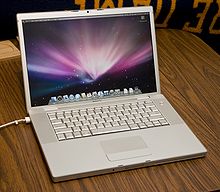 The MacBook Pro is the first Mac notebook to use an Intel processor. It was released at Macworld 2006.[83]
The MacBook Pro is the first Mac notebook to use an Intel processor. It was released at Macworld 2006.[83]
Apple discontinued the use of PowerPC microprocessors in 2006. At WWDC 2005, Steve Jobs revealed this transition and also noted that Mac OS X was in development to run both on Intel and PowerPC architecture from the very beginning.[84] All new Macs now use x86 processors made by Intel, and some Macs were given new names to signify the switch.[85] Intel-based Macs can run pre-existing software developed for PowerPC using an emulator called Rosetta,[86] although at noticeably slower speeds than native programs, and the Classic environment is unavailable. Intel chips introduced the potential to run the Microsoft Windows operating system natively on Apple hardware, without emulation software such as Virtual PC. In March 2006, a group of hackers announced that they were able to run Windows XP on an Intel-based Mac. The group released their software as open source and has posted it for download on their website.[87] On April 5, 2006, Apple announced the public beta availability of their own Boot Camp software that allows owners of Intel-based Macs to install Windows XP on their machines; later versions added support for Windows Vista. Boot Camp became a standard feature in Mac OS X 10.5, while support for Classic was dropped from PowerPC Macs.[88][89]
Starting in 2006, Apple's industrial design has shifted to favor aluminum, which was used in the construction of the first MacBook Pro. Glass was added in 2008 with the introduction of the unibody MacBook Pro. These materials are billed as environmentally friendly.[90] The iMac, MacBook Pro and MacBook Air lines use aluminum enclosures, and are now made of a single unibody.[91][92] Chief designer Jonathan Ive continues to guide products towards a minimalist and simple feel,[93][94] including the elimination of replaceable batteries in notebooks.[95] Multi-touch gestures from the iPhone's interface have been applied to the Mac line in the form of touch pads on notebooks and the Magic Mouse and Magic Trackpad for desktops.
In recent years, Apple has seen a significant boost in sales of Macs. This has been attributed, in part, to the success of the iPod and the iPhone, a halo effect whereby satisfied iPod or iPhone owners purchase more Apple equipment,[96] as well as the use of Intel microprocessors.[97] From 2001 to 2008, Mac sales increased continuously on an annual basis. Apple reported worldwide sales of 3.36 million Macs during the 2009 holiday season.[98] As of Mid-2011, Macintosh continues to enjoy rapid market share increase in the US, growing from 7.3% of all computer shipments in 2010 to 9.3% in 2011.[99]
On February 24, 2011, Apple was the first company to bring to market a computer that utilized Intel's new Thunderbolt (codename Light Peak) I/O interface. Using the same physical interface as a minidisplay port, and backwards compatible with that standard, Thunderbolt boasts two-way transfer speeds of 10 Gbit/s.[100]
Timeline of Macintosh models
Main article: Timeline of Macintosh models See also: Timeline of Apple II Family and Timeline of Apple Inc. products
See also: Timeline of Apple II Family and Timeline of Apple Inc. productsProduct line
Main article: Comparison of Macintosh modelsCompact Consumer Professional Desktop Mac mini

Entry-level; ships without keyboard, mouse, or monitor; uses Intel Core i5, or Intel Core i7 processorsiMac
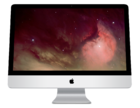
All-in-one; available in 21.5" and 27" screen sizes; uses Intel Core i3, Intel Core i5, or Intel Core i7 processorsMac Pro

Workstation desktop; highly customizable; Available with 4, 8 or 12 cores. Uses up-to two Intel Xeon X5650 "Westmere" (hexa-core) or Xeon X3460 "Nehalem" quad-core processorsPortable
(MacBook)MacBook Air
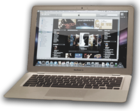
11.6" or 13.3" ultraportable with aluminum casing; uses Intel Core i5, or Intel Core i7 processorsMacBook Pro

13.3", 15.4" or 17" models with aluminum casing; uses Intel Core i5, or Intel Core i7 processorsServer Mac mini Server

An additional Mac mini configuration that ships with Mac OS X Server installed.Mac Pro Server

An additional Mac Pro server configuration that ships with Mac OS X Server installed.Hardware and software
Hardware
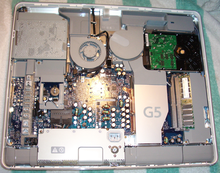 The internals of the original 20-inch iMac G5.
The internals of the original 20-inch iMac G5. Main article: Macintosh hardware
Main article: Macintosh hardwareApple directly sub-contracts hardware production to Asian original equipment manufacturers such as Asus, maintaining a high degree of control over the end product. By contrast, most other companies (including Microsoft) create software that can be run on hardware produced by a variety of third-parties, like Dell, HP/Compaq, and Lenovo. Consequently, the Macintosh buyer has comparably fewer options.
The current Mac product family uses Intel x86-64 processors. Apple introduced an emulator during the transition from PowerPC chips (called Rosetta), much as it did during the transition from Motorola 68000 architecture a decade earlier. The Macintosh is the only mainstream computer platform to have successfully transitioned to a new CPU architecture,[101] and has done so twice. All current Mac models ship with at least 2 GB RAM as standard. Current Mac computers use ATI Radeon or nVidia GeForce graphics cards as well as Intel graphics built into the main CPU. All current Macs (except for the MacBook Air and Mac Mini) ship with an optical media drive that includes a dual-function DVD/CD burner, called the SuperDrive. Macs include two standard data transfer ports: USB and FireWire (except for the MacBook Air and MacBook that do not include FireWire). MacBook Pro and MacBook Air computers now also feature the "Thunderbolt" port, which Apple says can transfer data at speeds up to 10 gigabytes per second. USB was introduced in the 1998 iMac G3 and is ubiquitous today,[3] while FireWire is mainly reserved for high-performance devices such as hard drives or video cameras. Starting with a new iMac G5 released in October 2005, Apple started to include built-in iSight cameras to appropriate models, and a media center interface called Front Row that can be operated by an Apple Remote or keyboard for accessing media stored on the computer.[102]
Apple was initially reluctant to embrace mice with multiple buttons and scroll wheels. Macs did not natively support multiple buttons, even from third parties, until Mac OS X arrived in 2001.[103] Apple continued to offer only single button mice, with wired and Bluetooth wireless versions, until August 2005, when it introduced the Mighty Mouse. While it looked like a traditional one-button mouse, it actually had four buttons and a scroll ball, capable of independent x- and y-axis movement.[104] A Bluetooth version followed in July 2006.[105] In October 2009, Apple introduced the Magic Mouse which uses multi-touch gesture recognition similar to the iPhone instead of a physical scroll wheel or ball.[106] It is available only in Bluetooth, and the Mighty Mouse (re-branded as "Apple Mouse") is available with a cord. Apple also features the "Magic Trackpad" as a means to control Macintosh desktop computers such as the iMac or Mac Pro. This was introduced in 2010.
Software
The original Macintosh was the first successful personal computer to use a graphical user interface devoid of a command line. It used a desktop metaphor, depicting real-world objects like documents and a trashcan as icons onscreen. The System software introduced in 1984 with the first Macintosh and renamed Mac OS in 1997, continued to evolve until version 9.2.2. In 2001, Apple introduced Mac OS X, based on Darwin and NEXTSTEP; its new features included the Dock and the Aqua user interface. During the transition, Apple included an emulator known as Classic allowing users to run Mac OS 9 applications under Mac OS X, version 10.4 and earlier on PowerPC machines. The most recent version is Mac OS X v10.7 "Lion." In addition to Lion, all new Macs are bundled with assorted Apple-produced applications, including iLife, the Safari web browser and the iTunes media player. Apple released Mac OS X 10.7 in 2010, which was made available in the summer of 2011. This operating system includes many new features such as: Mission Control, the Mac App Store (available to Mac OS X v10.6.6 "Snow Leopard." users by software update),Launchpad, an application viewer and launcher akin to the iOS Home Screen, and Resume, a feature similar to the hibernate function found in Microsoft Windows.
Historically Mac OS X enjoyed a near-absence of the types of malware and spyware that affect Microsoft Windows users.[107][108][109] Mac OS X has a smaller usage share compared to Microsoft Windows (roughly 5% and 92%, respectively),[110] but it also has secure UNIX roots. Worms as well as potential vulnerabilities were noted in February 2006, that led some industry analysts and anti-virus companies to issue warnings that Apple's Mac OS X is not immune to malware.[111] Increasing market share coincided with additional reports of a variety of attacks.[112] Apple releases security updates for its software.[113] In early 2011 Mac OS X experienced a large increase in malware attacks,[114] and malware such as Mac Defender, MacProtector, MacGuard were seen as an increasing problem for Mac users. At first, the malware installer required the user to enter the administrative password but later versions were able to install without user input[115] Initially Apple support staff were instructed not to assist in the removal of the malware or admit the existence of the malware issue, but as the malware spread a support document was issued and Apple announced a OS X update to fix the problem. An estimated 100,000 users were affected.[116][117]
Originally, the hardware architecture was so closely tied to the Mac OS operating system that it was impossible to boot an alternative operating system. The most common workaround, used even by Apple for A/UX, was to boot into Mac OS and then to hand over control to a program that took over the system and acted as a boot loader. This technique was no longer necessary with the introduction of Open Firmware-based PCI Macs, though it was formerly used for convenience on many Old World ROM systems due to bugs in the firmware implementation.[citation needed] Now, Mac hardware boots directly from Open Firmware (most PowerPC-based Macs) or EFI (all Intel-based Macs), and Macs are no longer limited to running just Mac OS X.
Following the release of the Intel-based Mac, third-party platform virtualization software such as Parallels Desktop, VMware Fusion, and VirtualBox began to emerge. These programs allow users to run Microsoft Windows or previously Windows-only software on Macs at near native speed. Apple also released Boot Camp and Mac-specific Windows drivers that help users to install Windows XP or Vista and natively dual boot between Mac OS X and Windows. Though not condoned by Apple, it is possible to run the Linux operating system using Boot camp or other virtualization workarounds.[118][119]
Because Mac OS X is a UNIX system, borrowing heavily from FreeBSD, many applications written for Linux or BSD run on Mac OS X, often using X11. Apple's smaller market share than Microsoft's means that a smaller range of shareware is available, but many popular commercial software applications from large developers such as Microsoft Office and Adobe Photoshop are ported to both Mac OS and Windows. And much of open source software like the Firefox web browser and the OpenOffice.org office suite are cross-platform and run natively.
Advertising
Main article: Apple Inc. advertisingMacintosh advertisements have usually attacked the established market leader, directly or indirectly. They tend to portray the Mac as an alternative to overly complex or unreliable PCs. Apple hyped the introduction of the original Mac with their 1984 commercial that aired during the Super Bowl.[120] It was supplemented by a number of printed pamphlets and other TV ads demonstrating the new interface and emphasizing the mouse. Many more brochures for new models like the Macintosh Plus and the Performa followed. In the 1990s, Apple started the "What's on your PowerBook?" campaign, with print ads and television commercials featuring celebrities describing how the PowerBook helps them in their businesses and everyday lives. In 1995, Apple responded to the introduction of Windows 95 with several print ads and a television commercial demonstrating its disadvantages and lack of innovation. In 1997 the Think Different campaign introduced Apple's new slogan, and in 2002 the Switch campaign followed. The most recent advertising strategy by Apple is the Get a Mac campaign, with North American, UK and Japanese variants.[121][122]
Today, Apple introduces new products at "special events" at the Apple Town Hall auditorium, and keynotes at the Apple Worldwide Developers Conference, and (formerly) trade shows like the Apple Expo and the MacWorld Expo. The events typically draw a large gathering of media representatives and spectators, and are preceded by speculation about possible new products. In the past, special events have been used to unveil its desktop and notebook computers such as the iMac and MacBook, and other consumer electronic devices like the iPod, Apple TV, and iPhone, as well as provide updates on sales and market share statistics. Apple has begun to focus its advertising on its retail stores instead of these trade shows; the last MacWorld keynote was in 2009.[123]
Since the introduction of the Macintosh, Apple has struggled to gain a significant share of the personal computer market. At first, the Macintosh 128K suffered from a dearth of available software compared to IBM's PC, resulting in disappointing sales in 1984 and 1985. It took 74 days for 50,000 units to sell.[124] Market share is measured by browser hits, sales and installed base. If using the browser metric, Mac market share has increased substantially in 2007.[125] If measuring market share by installed base, there were more than 20 million Mac users by 1997, compared to an installed base of around 340 million Windows PCs.[126][127] Statistics from late 2003 indicate that Apple had 2.06 percent of the desktop share in the United States that had increased to 2.88 percent by Q4 2004.[128] As of October 2006, research firms IDC and Gartner reported that Apple's market share in the U.S. had increased to about 6 percent.[129] Figures from December 2006, showing a market share around 6 percent (IDC) and 6.1 percent (Gartner) are based on a more than 30 percent increase in unit sale from 2005 to 2006. The installed base of Mac computers is hard to determine, with numbers ranging from 5% (estimated in 2009)[130] to 16% (estimated in 2005).[131] Mac OS X's share of the OS market increased from 7.31% in December 2007 to 9.63% in December 2008, which is a 32% increase in market share during 2008, compared with a 22% increase during 2007.
By March 2011, OS X market share in North America had increased to slightly over 14%.[132] Whether the size of the Mac's market share and installed base is relevant, and to whom, is a hotly debated issue. Industry pundits have often called attention to the Mac's relatively small market share to predict Apple's impending doom, particularly in the early and mid 1990s when the company's future seemed bleakest. Others argue that market share is the wrong way to judge the Mac's success. Apple has positioned the Mac as a higher-end personal computer, and so it may be misleading to compare it to a budget PC.[133] Because the overall market for personal computers has grown rapidly, the Mac's increasing sales numbers are effectively swamped by the industry's expanding sales volume as a whole. Apple's small market share, then, gives the impression that fewer people are using Macs than did ten years ago, when exactly the opposite is true.[134] Soaring sales of the iPhone and iPad mean that the portion of Apple's profits represented by the Macintosh has declined in 2010, dropping to 24% from 46% two years earlier.[135] Others try to de-emphasize market share, citing that it is rarely brought up in other industries.[136] Regardless of the Mac's market share, Apple has remained profitable since Steve Jobs' return and the company's subsequent reorganization.[137] Notably, a report published in the first quarter of 2008 found that Apple had a 14% market share in the personal computer market in the US, including 66% of all computers over $1,000.[138] Market research indicates that Apple draws its customer base from a higher-income demographic than the mainstream personal computer market.[139]
See also
- FrameByFrame
- Apple Inc. litigation
- Apple rumors community
- History of computing hardware (1960s-present)
- List of Macintosh models by case type
- List of Macintosh models grouped by CPU type
- List of Macintosh software
- List of Macintosh software published by Microsoft
- Mac gaming
- Reality distortion field
- Lilith (computer)
Notes
- ^ "Define Macintosh". Dictionary.com. http://dictionary.reference.com/browse/macintosh. Retrieved April 11, 2010.
- ^ Polsson, Ken (July 29, 2009). "Chronology of Apple Computer Personal Computers". http://www.islandnet.com/~kpolsson/applehis/appl1984.htm. Retrieved August 27, 2009. See May 3, 1984.
- ^ a b c Edwards, Benj (August 15, 2008). "Eight ways the iMac changed computing". Macworld. http://www.macworld.com/article/135017/2008/08/imacanniversary.html. Retrieved August 27, 2009.
- ^ "Xserve Transition Guide". November 5, 2010. http://images.apple.com/xserve/pdf/L422277A_Xserve_Guide.pdf. Retrieved November 5, 2010.
- ^ Raskin, Jef (1996). "Recollections of the Macintosh project". Articles from Jef Raskin about the history of the Macintosh.. http://mxmora.best.vwh.net/JefRaskin.html. Retrieved November 27, 2008.
- ^ Apple confidential 2.0: the definitive history of the world's most colorful company, Owen W. Linzmayer, ISBN 978-1-59327-010-0
- ^ a b Hertzfeld, Andy. "The father of the Macintosh". Folklore.org. http://www.folklore.org/StoryView.py?project=Macintosh&story=The_Father_of_The_Macintosh.txt&showcomments=1#comments. Retrieved April 24, 2006.
- ^ Crow, George. "The Original Macintosh". Folklore.org. http://www.folklore.org/ProjectView.py?project=Macintosh&characters=George%20Crow. Retrieved April 28, 2010.
- ^ Kottke, Dan. "The Original Macintosh". Folklore.org. http://www.folklore.org/ProjectView.py?project=Macintosh&characters=Dan%20Kottke. Retrieved April 28, 2010.
- ^ Manock, Jerry. "The Original Macintosh". Folklore.org. Archived from the original on September 29, 2007. http://web.archive.org/web/20070929111006/http://folklore.org/ProjectView.py?project=Macintosh&characters=Jerry%20Manock. Retrieved April 28, 2010.
- ^ Kawasaki, Guy (January 26, 2009). "Macintosh 25th Anniversary Reunion: Where Did Time Go?". http://blog.guykawasaki.com/2009/01/twenty-five-yea.html#axzz0mQb8tIS0. Retrieved April 28, 2010.
- ^ Hertzfeld, Andy. "Five different Macintoshes". Folklore.org. http://www.folklore.org/StoryView.py?story=Five_Different_Macs.txt. Retrieved April 24, 2006.
- ^ Horn, Bruce. "On Xerox, Apple and Progress". Folklore.org. http://www.folklore.org/StoryView.py?project=Macintosh&story=On_Xerox,_Apple_and_Progress.txt. Retrieved February 3, 2007.
- ^ Tracy, Ed. "History of computer design: Snow White". Landsnail.com. http://www.landsnail.com/apple/local/design/design2.html. Retrieved April 24, 2006.
- ^ Hertzfeld, Andy. "The End Of An Era". folklore.org. http://www.folklore.org/StoryView.py?project=Macintosh&story=The_End_Of_An_Era.txt.
- ^ Spector, G (September 24, 1985). "Apple's Jobs Starts New Firm, Targets Education Market". PCWeek: p. 109.
- ^ "Apple Computer, Inc. Finalizes Acquisition of NeXT Software Inc.". Apple. February 7, 1997. Archived from the original on January 17, 1999. http://web.archive.org/web/19990117075346/http://product.info.apple.com/pr/press.releases/1997/q2/970207.pr.rel.next.html. Retrieved April 27, 2010.
- ^ "Apple Macintosh 18 Page Brochure". DigiBarn Computer Museum. http://www.digibarn.com/collections/ads/apple-mac/index.htm. Retrieved April 24, 2006.
- ^ Linzmayer, Owen W. (2004). Apple Confidential 2.0. No Starch Press. p. 113. ISBN 1-59327-010-0. http://www.owenink.com.
- ^ Maney, Kevin (January 28, 2004). "Apple's '1984' Super Bowl commercial still stands as watershed event". USA Today. http://www.usatoday.com/tech/columnist/kevinmaney/2004-01-28-maney_x.htm. Retrieved April 11, 2010.
- ^ Leopold, Todd (February 3, 2006). "Why 2006 isn't like '1984'". CNN. http://edition.cnn.com/2006/SHOWBIZ/02/02/eye.ent.commercials/. Retrieved May 10, 2008.
- ^ Cellini, Adelia (January 2004). "The Story Behind Apple's '1984' TV commercial: Big Brother at 20". MacWorld 21.1, page 18. Archived from the original on June 26, 2008. http://web.archive.org/web/20080626112220/http://findarticles.com/p/articles/mi_hb197/is_200401/ai_n5556112. Retrieved May 9, 2008.
- ^ Long, Tony (January 22, 2007). "Jan. 22, 1984: Dawn of the Mac". Wired. http://www.wired.com/science/discoveries/news/2007/01/72496. Retrieved April 11, 2010.
- ^ Kahney, Leander (January 6, 2004). "We're All Mac Users Now". Wired. http://www.wired.com/gadgets/mac/news/2004/01/61730. Retrieved April 11, 2010.
- ^ Polsson, Ken. "Chronology of Apple Computer Personal Computers". http://www.islandnet.com/~kpolsson/applehis/appl1984.htm. Retrieved November 18, 2007.
- ^ Beamer, Scott (January 13, 1992). "For Lotus, third time's the charm". MacWEEK. http://www.accessmylibrary.com/article-1G1-11721498/lotus-third-time-charm.html. Retrieved June 23, 2010.
- ^ a b Hormby, Thomas (October 2, 2006). "Apple's Worst Business Decisions". OS News. http://www.osnews.com/story/16036/Apples-Worst-Business-Decisions/. Retrieved December 24, 2007.
- ^ "1984 Newsweek Macintosh ads". GUIdebook, Newsweek. http://www.guidebookgallery.org/ads/magazines/macos/macos10-newsweek. Retrieved April 24, 2006.
- ^ "Inflation Calculator". Bureau of Labor Statistics. http://data.bls.gov/cgi-bin/cpicalc.pl. Retrieved May 14, 2010.
- ^ Spring, Michael B. (1991). Electronic printing and publishing: the document processing revolution. CRC Press. pp. 125–126. ISBN 9780824785444. http://books.google.com/?id=_MV46vFUrI4C&pg=PA125&dq=Desktop+publishing+history+of&cd=5#v=onepage&q=Desktop%20publishing%20history%20of.
- ^ Technical specifications of Macintosh 512K from Apple's knowledge base and from EveryMac.com. Retrieved June 23, 2010.
- ^ Technical specifications of Macintosh Plus from Apple's knowledge base and from EveryMac.com. Retrieved June 23, 2010.
- ^ Technical specifications of Macintosh II from Apple's knowledge base and from EveryMac.com. Retrieved June 23, 2010.
- ^ "Apple Macintosh II". Old Computers On-line Museum. http://www.old-computers.com/museum/computer.asp?st=1&c=160. Retrieved December 23, 2007.
- ^ "Macintosh II Family: Fan Regulator Voids Warranty". Apple. July 2, 1992. http://support.apple.com/kb/TA40560. Retrieved December 23, 2007.
- ^ Technical specifications of Macintosh SE from Apple's knowledge base and from EveryMac.com. Retrieved June 23, 2010.
- ^ "Apple Service Source: Apple SE/30". http://www.apple-collection.com/CarPos/macse30.pdf. Retrieved November 16, 2010.
- ^ Hearm, Bob (2003). "A Brief History of ClarisWorks". MIT Project on Mathematics and Computation. http://www-swiss.ai.mit.edu/~bob/clarisworks.php. Retrieved December 24, 2007.
- ^ Free Software Foundation (June 11, 1988). "Special Report: Apple's New Look and Feel". GNU's Bulletin 1 (5). http://www.gnu.org/bulletins/bull5.html#SEC9. Retrieved April 25, 2006.
- ^ Free Software Foundation (1995-01). "End of Apple Boycott". GNU's Bulletin 1 (18). http://www.gnu.org/bulletins/bull18.html#SEC13. Retrieved April 25, 2006.
- ^ Technical specifications of Macintosh IIx from Apple's knowledge base and from EveryMac.com. Retrieved June 23, 2010.
- ^ Technical specifications of Macintosh IIcx from Apple's knowledge base and from EveryMac.com. Retrieved June 23, 2010.
- ^ Technical specifications of Macintosh SE/30 from Apple's knowledge base and from EveryMac.com. Retrieved June 23, 2010.
- ^ Technical specifications of Macintosh IIci from Apple's knowledge base and from EveryMac.com. Retrieved June 23, 2010.
- ^ Knight, Dan (2001-01). "32-bit Addressing on Older Macs". Low End Mac. http://lowendmac.com/trouble/32bit.shtml. Retrieved December 24, 2007.
- ^ Technical specifications of Macintosh Portable from Apple's knowledge base and from EveryMac.com. Retrieved June 23, 2010.
- ^ Technical specifications of Macintosh IIfx from Apple's knowledge base and from EveryMac.com. Retrieved June 23, 2010.
- ^ a b Fisher, Lawrence M. (October 15, 1990). "Less-Costly Apple Line To Be Presented Today". The New York Times. http://query.nytimes.com/gst/fullpage.html?res=9C0CEFD9163CF936A25753C1A966958260. Retrieved January 16, 2008.
- ^ Technical specifications of Macintosh LC from Apple's knowledge base and from EveryMac.com. Retrieved June 24, 2010.
- ^ Technical specifications of Macintosh IIsi from Apple's knowledge base and from EveryMac.com. Retrieved June 24, 2010.
- ^ Fisher, Lawrence M. (January 18, 1991). "I.B.M. Surprises Wall Street With Strong Quarterly Net; Apple Posts 20.6% Rise". The New York Times. http://query.nytimes.com/gst/fullpage.html?res=9D0CE2DA163BF93BA25752C0A967958260. Retrieved January 16, 2008.
- ^ Technical specifications of Macintosh Classic II from Apple's knowledge base and from EveryMac.com. Retrieved June 24, 2010.
- ^ Technical specifications of Macintosh LC II from Apple's knowledge base and from EveryMac.com. Retrieved June 24, 2010.
- ^ Technical specifications of Macintosh Quadra 700 from Apple's knowledge base and from EveryMac.com. Retrieved June 24, 2010.
- ^ Technical specifications of Macintosh Quadra 900 from Apple's knowledge base and from EveryMac.com. Retrieved June 24, 2010.
- ^ Hormby, Thomas (January 3, 2005). "Apple's Transition to PowerPC put in perspective". Kaomso. http://www.kaomso.com/FullStory.php?TheStory=78. Retrieved December 24, 2007.
- ^ Polsson, Ken (December 16, 2007). "Chronology of Apple Computer Personal Computers". http://www.islandnet.com/~kpolsson/applehis/appl1994.htm. Retrieved December 24, 2007.
- ^ Polsson, Ken. "Chronology of Apple Computer Personal Computers". http://www.islandnet.com/~kpolsson/applehis/appl1990.htm. Retrieved November 18, 2007.
- ^ Jade, Kasper (February 16, 2007). "Apple to re-enter the sub-notebook market". AppleInsider. http://www.appleinsider.com/articles/07/02/16/apple_to_re_enter_the_sub_notebook_market.html. Retrieved December 24, 2007.
- ^ Technical specifications of PowerBook 165c from Apple's knowledge base and from EveryMac.com. Retrieved June 24, 2010.
- ^ Technical specifications of PowerBook 520 from Apple's knowledge base and from EveryMac.com. Retrieved November 12, 2010.
- ^ Kunkel, Paul (October 1, 1997). AppleDesign: The work of the Apple Industrial Design Group. Rick English (photographs). New York City: Graphis Inc.. ISBN 1888001259.
- ^ Apple Computer (June 19, 1995). "Macintosh Centris, Quadra 660AV: Description (Discontinued)". http://docs.info.apple.com/article.html?artnum=12707. Retrieved December 24, 2007.
- ^ EveryMac.com (October 27, 2009). "Umax Mac Clones (MacOS-Compatible Systems)". http://www.everymac.com/systems/umax/index-umax-supermac-mac-clones.html. Retrieved November 11, 2009.
- ^ EveryMac.com (October 27, 2009). "PowerComputing Mac Clones (MacOS-Compatible Systems)". http://www.everymac.com/systems/powercc/index-power-computing-mac-clones.html. Retrieved November 11, 2009.
- ^ Knight, Dan (August 30, 2007). "1997: Apple Squeezes Mac Clones Out of the Market". Low End Mac. http://lowendmac.com/musings/mm07/0830.html. Retrieved December 24, 2007.
- ^ Engst, Adam (January 23, 2009). "The six worst Apple products of all time". Macworld. http://www.macworld.com/article/138404/2009/01/macat25_worstproducts.html. Retrieved May 14, 2010.
- ^ Technical specifications of iMac G3 from Apple's knowledge base and from EveryMac.com. Retrieved June 24, 2010.
- ^ "800,000 iMacs Sold in First 139 Days". Apple. January 5, 1999. http://www.apple.com/ca/press/1999/01/iMac_Sales.html. Retrieved December 23, 2007.
- ^ Markoff, John (October 15, 1998). "COMPANY REPORTS; Apple's First Annual Profit Since 1995". The New York Times. http://query.nytimes.com/gst/fullpage.html?res=9D0CE6D8123AF936A25753C1A96E958260. Retrieved December 23, 2007.
- ^ "iBook: An iMac to Go". http://db.tidbits.com/article/5487?print_version=1.
- ^ "Apple Averages Three Thousand iBooks Per Day In Pre-orders!". The Mac Observer. August 31, 1999. http://www.macobserver.com/news/99/august/990831/140000ibooks.html. Retrieved December 24, 2007.
- ^ "PC Data Ranks iBook Number One Portable in U.S.". Apple. January 25, 2000. http://www.apple.com/pr/library/2000/jan/25ibook.html. Retrieved December 18, 2007.
- ^ "Speed, Song Highlight Apple Product Announcements". http://pcworld.about.com/news/Jan092001id37951.htm.
- ^ "Apple picks up the beat with CD-RW drives". http://news.cnet.com/Apple-picks-up-the-beat-with-CD-RW-drives/2100-1040_3-249578.html.
- ^ <http://www.macworld.com/article/3744/2002/03/eisner2.html>
- ^ "The Complete iTunes History – SoundJam MP to iTunes 9". http://www.maclife.com/article/feature/complete_itunes_history_soundjam_mp_itunes_9.
- ^ "About the Macintosh Cube" (PDF). Apple. 2000. http://manuals.info.apple.com/en/PowerMacG4_CubeAbout.PDF. Retrieved October 9, 2008.
- ^ Markoff, John; Hansell, Saul (January 12, 2005). "Apple Changes Course With Low-Priced Mac". The New York Times. http://www.nytimes.com/2005/01/12/technology/12apple.html. Retrieved January 16, 2006.
- ^ Apple unveils low-cost 'Mac mini'. BBC News. January 11, 2005. http://news.bbc.co.uk/1/hi/technology/4162009.stm. Retrieved April 28, 2010
- ^ "Apple Developer Connection – Overview of the PowerPC System Software". Apple. http://developer.apple.com/documentation/mac/PPCSoftware/PPCSoftware-12.html#HEADING12-0. Retrieved May 11, 2009.
- ^ Biersdorfer, J.D. (September 14, 2000). "Apple Breaks The Mold". The New York Times. http://query.nytimes.com/gst/fullpage.html?res=9F01E2DD1538F937A2575AC0A9669C8B63. Retrieved January 16, 2008.
- ^ Technical specifications of MacBook Pro from Apple's knowledge base and from EveryMac.com. Retrieved June 24, 2010.
- ^ "Apple to Use Intel Microprocessors Beginning in 2006". Apple. June 6, 2005. http://www.apple.com/pr/library/2005/jun/06intel.html. Retrieved May 14, 2010.
- ^ Michaels, Philip (January 2, 2010). "Apple's most significant products of the decade". Macworld. http://www.macworld.com/article/145380/2010/01/10significantapplemoves.html. Retrieved May 14, 2010.
- ^ "WWDC 2005 Keynote Live Update". Macworld. June 6, 2005. http://www.macworld.com/article/45157/2005/06/liveupdate.html. Retrieved May 14, 2010.
- ^ "Hackers get Windows XP to run on a Mac". MSNBC (AP). March 17, 2006. http://www.msnbc.msn.com/id/11885495/. Retrieved April 24, 2006.
- ^ "Boot Camp". Apple. http://www.apple.com/support/bootcamp/. Retrieved May 17, 2010.
- ^ Dalrymple, Jim (March 5, 2006). "New Apple software lets Intel Macs boot Windows". Macworld. http://www.macworld.com/article/50204/2006/04/bootcamp.html. Retrieved May 14, 2010.
- ^ "The story behind Apple's environmental footprint.". Apple. http://www.apple.com/environment/. Retrieved January 24, 2011.
- ^ "New MacBook Family Redefines Notebook Design". Apple. October 14, 2008. http://www.apple.com/pr/library/2008/10/14macbook.html. Retrieved December 23, 2009.
- ^ Lam, Brian (October 20, 2009). "Apple iMac Hands On". Gizmodo. http://gizmodo.com/5385841/apple-imac-hands-on. Retrieved August 18, 2010.
- ^ Kahney, Leander (June 25, 2003). "Design According to Ive". Wired. http://www.wired.com/culture/design/news/2003/06/59381?currentPage=all. Retrieved December 23, 2009.
- ^ Nosowitz, Dan (November 7, 2009). "Watch Jonathan Ive's Segment in Objectified". Gizmodo. http://gizmodo.com/5399420/watch-jonathan-ives-segment-in-objectified. Retrieved December 23, 2009.
- ^ "Apple Updates MacBook Pro Family with New Models & Innovative Built-in Battery for Up to 40% Longer Battery Life". Apple. June 8, 2009. http://www.apple.com/pr/library/2009/06/08mbp.html. Retrieved December 23, 2009.
- ^ Apple Aims for the Masses With a Cheaper iPhone
- ^ Windows or Mac? Apple Says Both
- ^ "Apple Reports First Quarter Results". Apple. January 25, 2009. http://www.apple.com/pr/library/2010/01/25results.html.
- ^ "Apple’s Mac market share grows 18.9% in first quarter". Loopinsight.com. April 13, 2011. http://www.loopinsight.com/2011/04/13/apples-mac-market-share-grows-18-9-in-first-quarter/. Retrieved July 5, 2011.
- ^ "Thunderbolt Technology: The Fastest Data Connection to Your PC Just Arrived". http://newsroom.intel.com/community/intel_newsroom/blog/2011/02/24/thunderbolt-technology-the-fastest-data-connection-to-your-pc-just-arrived.
- ^ "Apple Switch". http://www.pcmag.com/article2/0,2817,933453,00.asp.
- ^ "Apple Introduces the New iMac G5". Apple. October 12, 2005. http://www.apple.com/pr/library/2005/oct/12imac.html. Retrieved July 12, 2006.
- ^ "Eek! A Two-Button Mac Mouse?". Wired. October 30, 2000. http://www.wired.com/science/discoveries/news/2000/10/39773. Retrieved December 23, 2009.
- ^ "Apple Introduces Mighty Mouse". Apple. August 2, 2005. http://www.apple.com/pr/library/2005/aug/02mightymouse.html. Retrieved July 12, 2006.
- ^ "Apple Debuts Wireless Mighty Mouse". Apple. July 25, 2006. http://www.apple.com/pr/library/2006/jul/25mightymouse.html. Retrieved November 30, 2007.
- ^ "Apple Introduces Magic Mouse—The World's First Multi-Touch Mouse". Apple. October 20, 2009. http://www.apple.com/pr/library/2009/10/20magicmouse.html. Retrieved December 24, 2009.
- ^ Welch, John (January 6, 2007). "Review: Mac OS X Shines In Comparison With Windows Vista". Information Week. http://www.informationweek.com/news/showArticle.jhtml?articleID=196800670&pgno=4. Retrieved February 5, 2007.
- ^ Granneman, Scott (October 6, 2003). "Linux vs. Windows Viruses". The Register. http://www.theregister.co.uk/2003/10/06/linux_vs_windows_viruses/. Retrieved February 5, 2007.
- ^ Gruber, John (June 4, 2004). "Broken Windows". Daring Fireball. http://daringfireball.net/2004/06/broken_windows. Retrieved April 24, 2006.
- ^ "Operating System Market Share". September 2009. http://marketshare.hitslink.com/operating-system-market-share.aspx?qprid=8. Retrieved April 10, 2009.
- ^ Roberts, Paul (February 21, 2006). "New Safari Flaw, Worms Turn Spotlight on Apple Security". eWeek. http://www.eweek.com/article2/0,1895,1929342,00.asp. Retrieved November 23, 2007.
- ^ Conneally, Tim (August 28, 2009). "'Macs don't get viruses' myth dissolves before public's eyes". BetaNews.com. http://www.betanews.com/article/Macs-dont-get-viruses-myth-dissolves-before-publics-eyes/1251493625.
- ^ "Apple security updates". Apple. January 21, 2009. http://support.apple.com/kb/HT1222. Retrieved January 29, 2009.
- ^ Grimes, Roger A. (May 23, 2011). "7 questions about the Mac malware scare | Security". InfoWorld. http://www.infoworld.com/d/security/7-questions-about-the-mac-malware-scare-811. Retrieved July 5, 2011.
- ^ "Mac Security Boasts Threatened by Malware Surge – International Business Times". Ibtimes.com. May 26, 2011. http://www.ibtimes.com/articles/152612/20110526/mac-security-boasts-threatened-by-malware-surge.htm. Retrieved July 5, 2011.
- ^ Trenholm, Rich (May 20, 2011). "Apple tells support staff not to confirm Mac Defender infections". UK: Crave.. http://crave.cnet.co.uk/software/apple-tells-support-staff-not-to-confirm-mac-defender-infections-50003832/. Retrieved July 5, 2011.
- ^ "Mac Defender 2.0 Released – Security Watch". PC Mag. May 25, 2011. http://blogs.pcmag.com/securitywatch/2011/05/mac_defender_20_released.php. Retrieved July 5, 2011.
- ^ Lucas, Paul (June 4, 2005). "Paul J. Lucas's Mac Mini running Linux". http://homepage.mac.com/pauljlucas/personal/macmini/index.html. Retrieved December 23, 2009.
- ^ Hoover, Lisa (April 11, 2008). "Virtualization Makes Running Linux a Snap". http://ostatic.com/blog/virtualization-makes-running-linux-a-snap. Retrieved December 23, 2009.
- ^ Pogue, David; Joseph Schorr (1993). Macworld Macintosh SECRETS. San Mateo: IDG Books Worldwide, Inc.. p. 251. ISBN 1-56884-025-X.
- ^ "Get a Mac advertisements". Apple. http://www.apple.com/uk/getamac/. Retrieved January 29, 2007.
- ^ "Get a Mac". Apple. http://www.apple.com/jp/getamac/. Retrieved February 3, 2007.
- ^ "Apple Announces Its Last Year at Macworld". Apple. December 16, 2008. http://www.apple.com/pr/library/2008/12/16macworld.html. Retrieved March 30, 2009.
- ^ Polsson, Ken (July 29, 2009). "Chronology of Apple Computer Personal Computers". http://www.islandnet.com/~kpolsson/applehis/appl1984.htm. Retrieved August 27, 2009. See April 7, 1984.
- ^ "Trends in Mac market share". Ars Technica. April 5, 2009. http://arstechnica.com/journals/apple.ars/2007/04/05/trends-in-mac-market-share. Retrieved August 27, 2009.
- ^ "Apple Developer News, No. 87". Apple Computer. December 19, 1997. http://developer.apple.com/adcnews/pastissues/devnews121997.html#stats. Retrieved April 24, 2006.[dead link]
- ^ "Nearly 600 Million Computers-in-Use in Year 2000". Computer Industry Almanac Inc. November 3, 1998. http://www.c-i-a.com/pr1198.htm. Retrieved June 1, 2006.
- ^ Dalrymple, Jim (April 20, 2005). "Apple desktop market share on the rise; will the Mac mini, iPod help?". Macworld. http://www.macworld.com/news/2005/03/20/marketshare/index.php. Retrieved April 24, 2006.
- ^ Dalrymple, Jim (October 19, 2006). "Apple's Mac market share tops 5% with over 30% growth". Macworld. http://www.macworld.com/news/2006/10/19/marketshare/index.php. Retrieved December 22, 2006.
- ^ "Operating System Market Share". Hitslink. July 2009. http://marketshare.hitslink.com/operating-system-market-share.aspx?qprid=8. Retrieved August 27, 2009.
- ^ MacDailyNews (June 15, 2005). "16% of computer users are unaffected by viruses, malware because they use Apple Macs". http://macdailynews.com/index.php/weblog/comments/5933/. Retrieved April 24, 2006.
- ^ [1]
- ^ Gruber, John (July 23, 2003). "Market Share". Daring Fireball. http://daringfireball.net/2003/07/market_share. Retrieved April 24, 2006.
- ^ Brockmeier, Joe (May 13, 2003). "What Will It Take To Put Apple Back on Top?". NewsFactor Magazine online. http://www.newsfactor.com/perl/story/21499.html. Retrieved April 24, 2006.[dead link]
- ^ "Despite growing sales, Mac's share of Apple profits wanes". http://www.thenewstribune.com/2010/10/21/1390638/despite-growing-sales-macs-share.html.
- ^ Toporek, Chuck (August 22, 2001). "Apple, Market Share, and Who Cares?". O'Reilly macdevcenter.com. http://www.oreillynet.com/mac/blog/2001/08/apple_market_share_and_who_car.html. Retrieved April 24, 2006.
- ^ Spero, Ricky (July 14, 2004). "Apple Posts Profit of $61 million; Revenue Jumps 30%". The Mac Observer. http://www.macobserver.com/stockwatch/2004/07/14.1.shtml. Retrieved April 24, 2006.
- ^ Wilcox, Joe. "Macs Defy Windows' Gravity". Apple Watch. http://blogs.eweek.com/applewatch/content/channel/macs_defy_windows-gravity.html. Retrieved May 19, 2008.
- ^ Fried, Ian (July 12, 2002). "Are Mac users smarter?". news.com. http://news.com.com/2100-1040-943519.html. Retrieved April 24, 2006.
References
- Apple & Raskin, Jef (1992). Macintosh Human Interface Guidelines. Addison-Wesley Professional. ISBN 0-201-62216-5.
- Apple. "Press release Library". http://www.apple.com/pr/library/. Retrieved November 18, 2007.
- Deutschman, Alan (2001). The Second Coming of Steve Jobs. Broadway. ISBN 0-7679-0433-8.
- Hertzfeld, Andy. "folklore.org: Macintosh stories". http://folklore.org/index.py. Retrieved April 24, 2006.
- Hertzfeld, Andy (2004). Revolution in the Valley. O'Reilly Books. ISBN 0-596-00719-1.
- Kahney, Leander (2004). The Cult of Mac. No Starch Press. ISBN 1-886411-83-2.
- Kawasaki, Guy (1989). The Macintosh Way. Scott Foresman Trade. ISBN 0-673-46175-0.
- Kelby, Scott (2002). Macintosh... The Naked Truth. New Riders Press. ISBN 0-7357-1284-0.
- Knight, Dan (2005). "Macintosh History: 1984". http://lowendmac.com/history/1984dk.shtml. Retrieved April 24, 2006.
- Levy, Steven (2000). Insanely Great: The Life and Times of Macintosh, the Computer That Changed Everything. Penguin Books. ISBN 0-14-029177-6.
- Linzmayer, Owen (2004). Apple Confidential 2.0. No Starch Press. ISBN 1-59327-010-0.
- Page, Ian (2007). "MacTracker Macintosh model database 4.3.1". http://www.mactracker.ca/. Retrieved November 31, 2007.
- Sanford, Glen (2006). "Apple History". http://www.apple-history.com/. Retrieved April 24, 2006.
- Singh, Amit (2005). "A History of Apple's Operating Systems". http://www.kernelthread.com/mac/oshistory/. Retrieved April 24, 2006.
External links
Apple hardware before 1998 Computers AppleApple I · Apple II series (II, II Plus, II Europlus, II J-Plus) · IIe series (IIe, IIe Card for Macintosh LC series) · IIc series (IIc, IIc Plus) · IIGS · Apple III series (Apple III, III Plus)LC series (LC II (Performa 400–410), LC III (Performa 450), LC III+ (Performa 460–467)) · LC 500 series (LC 520 (Performa 520, Macintosh TV), LC 550 (Performa 550–560), LC 575 (Performa 575–578), LC 580 (Performa 580)) · 5200/5300 LC series (5200 LC (Performa 5200–5220), 5260 (Performa 5260–5280), 5300 LC (Performa 5300–5320))Macintosh Portable · 100 series (100, 140, 170, 145, 160, 180, 165, 145B, 165c, 180c, 150) · Duo series (210, 230, 250, 270c, 280, 280c, 2300c, Duo Dock) · 500 series (520, 520c, 540, 540c, 550c) · 190 series (190, 190cs) · 5300 series (5300, 5300cs, 5300c, 5300ce) · 1400 series (1400c, 1400cs) · 3400c · 2400c · G36100 (Performa 6110–6118), AWS 6150) · 7100 · 8100 (AWS 8150) · AWS 9150 · 5000 series (5200 LC, (Performa 5215CD), 5260, 5300 LC, 5400, 5500) · 6200/6300 series (6200, (Performa 6200–6230), 6300 (Performa 6260–6360)) · 9500 · 7200 (AWS 7250) · 7500 · 8500 (AWS 8550) · 5400 (Performa 5400–5440) · 7600 · 6400 (Performa 6400, 6410, 6420) · 4400 (7220) · 5500 · 6500 · 7300 (AWS 7350) · 8600 · 9600 (AWS 9650) · G3 · Twentieth Anniversary MacPeripherals Monitor III · Monitor II · Monitor IIc · AppleColor Composite IIe · AppleColor High-Resolution RGB · Macintosh Color · AudioVision 14 · Multiple Scan 14 · ColorSync 750External drivesFloppy drives (Apple II and III, Macintosh) · Hard drives (ProFile, Hard Disk 20, Hard Disk 20SC) · Optical drives (AppleCD, PowerCD) · Tape drives (40SC)Input devicesExternal Keyboards (Numeric Keypad IIe, Lisa Keyboard, Macintosh Keyboard, Macintosh Numeric Keypad, Macintosh Plus Keyboard, ADB Keyboard, Standard Keyboard, Extended, Apple Keyboard II, Extended Keyboard II, Adjustable, Newton Keyboard, Apple Design Keyboard, Twentieth Anniversary Mac Keyboard) · Mice (Lisa, Macintosh, Mouse IIc, AppleMouse II, Apple Mouse, Mouse IIe, ADB Mouse, ADB Mouse II) · Mouse derivatives (Apple II Graphics Tablet, Joystick) · Scanner · OneScanner · Color OneScanner (Color OneScanner, 600/27) · QuickTake cameras (100, 150, 200) · QuickTime Conferencing KitNetworkingApple II Communications Card · Apple Modems · LocalTalk network adapter · Comm slot cards · GeoPort Telecom AdaptersPrintersThermal (Silentype, Thermal Printer, Scribe Printer) · Impact (Dot Matrix Printer, Letter Quality Printer, ImageWriter, ImageWriter II, ImageWriter LQ) · LaserWriter (LaserWriter, Plus, IISC, IINT, IINTX, IIf, IIg, 4/600 PS, 16/600 PS, 12/640 PS, 8500) · Plotter (410 Color Plotter) · Personal LaserWriter (SC, LS, NT, NTR, 300, 320) · LaserWriter Pro (600, 630, 810) · LaserWriter Select (300, 310, 360) · Color LaserWriter (12/600 PS, 12/660 PS) · StyleWriter (StyleWriter, II, 1200, Portable) · Color Printer · Color StyleWriter (Pro, 2400, 2200, 1500, 2500, 4100, 4500, 6500)OtherSee also: Apple hardware since 1998.Apple hardware since 1998 Consumer computers Professional computers Notebook computers Consumer electronics Apple TV · Displays (Thunderbolt, Cinema, Studio) · iPad (Original, 2) · iPhone (Original, 3G, 3GS, 4, 4S) · iPod (Classic: 1G, 2G, 3G, 4G, Photo, 5G, 6G; Mini: 1G, 2G; iPod+HP; Shuffle: 1G, 2G, 3G, 4G; Nano: 1G, 2G, 3G, 4G, 5G, 6G; Touch: 1G, 2G, 3G, 4G) · Newton (MessagePad: 2000, 2100; eMate 300)Accessories AirPort (Card: B, G, N; Base Station: Graphite, Snow, Extreme G, N, Express G, N) · iPod (Click Wheel, Dock Connector, Camera Connector, iPod Hi-Fi, Nike+iPod) · iSight · Keyboard (Pro, Wireless) · Magic Trackpad · Mouse (USB, Pro, Wireless, Mighty, Magic) · Remote · SuperDrive · Time Capsule · USB Modem · Xserve RAIDItalics indicate discontinued products, See also: Apple hardware before 1998.Macintosh operating systems Classic Mac OS (history) Mac OS X (history) Server Other OS projects Mac OS Applications Calculator · Chooser · Drive Setup · DVD Player · Finder · Graphing Calculator · Keychain Access · PictureViewer · PowerTalk · QuickTime Player · Network Browser · Scrapbook · Sherlock · Software Update · Stickies · Apple System Profiler · SimpleTextDeveloper Technology Alias · Apple menu · Balloon help · Bomb Error · Command (⌘) · Control Panel · Control Strip · Creator code · Hierarchical File System · HFS Plus · Keychain · Labels · Macintosh File System · Option (⌥) · OSType · PICT · QuickDraw · QuickTime · Resource fork · Special menu · Startup Screen · System Folder · System suitcase · Type code · WorldScriptRelated articles Categories:- 1984 introductions
- Engineering and technology good articles
- Industrial designs
- Macintosh computers
- Macintosh platform
- Personal computers
- Sealed computers
- Steve Jobs
- Apple Inc. employees
Wikimedia Foundation. 2010.

